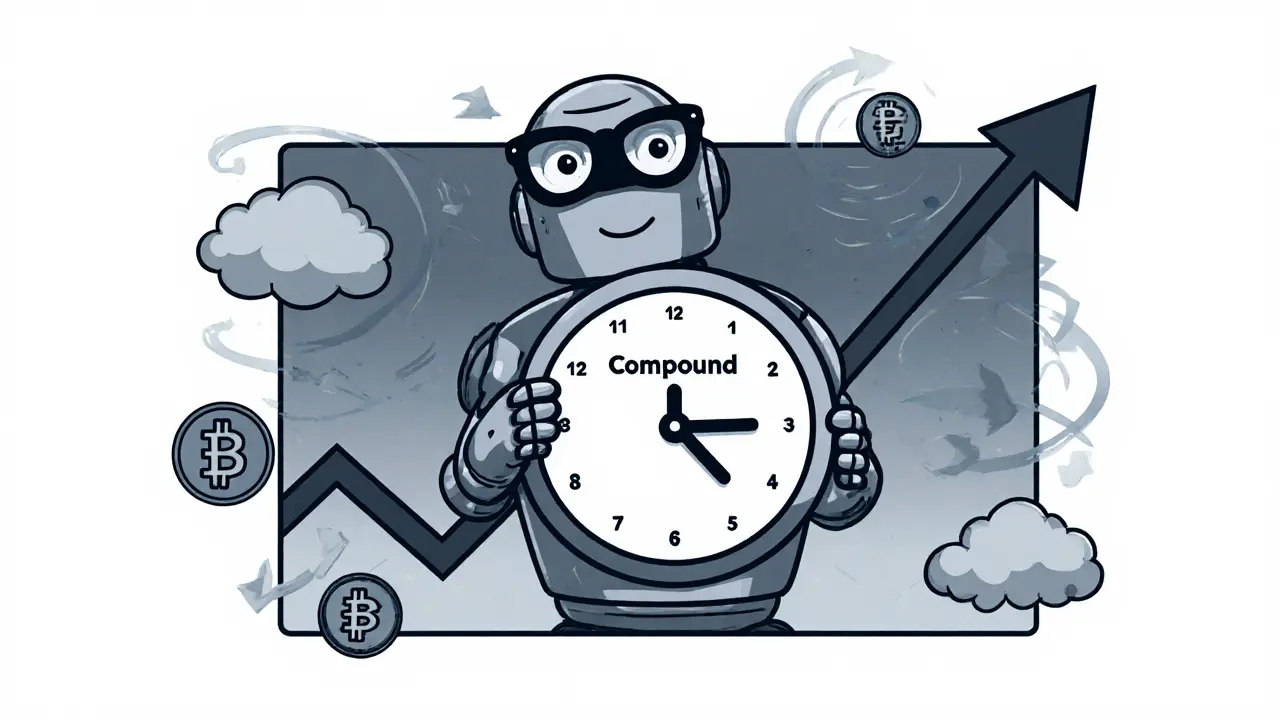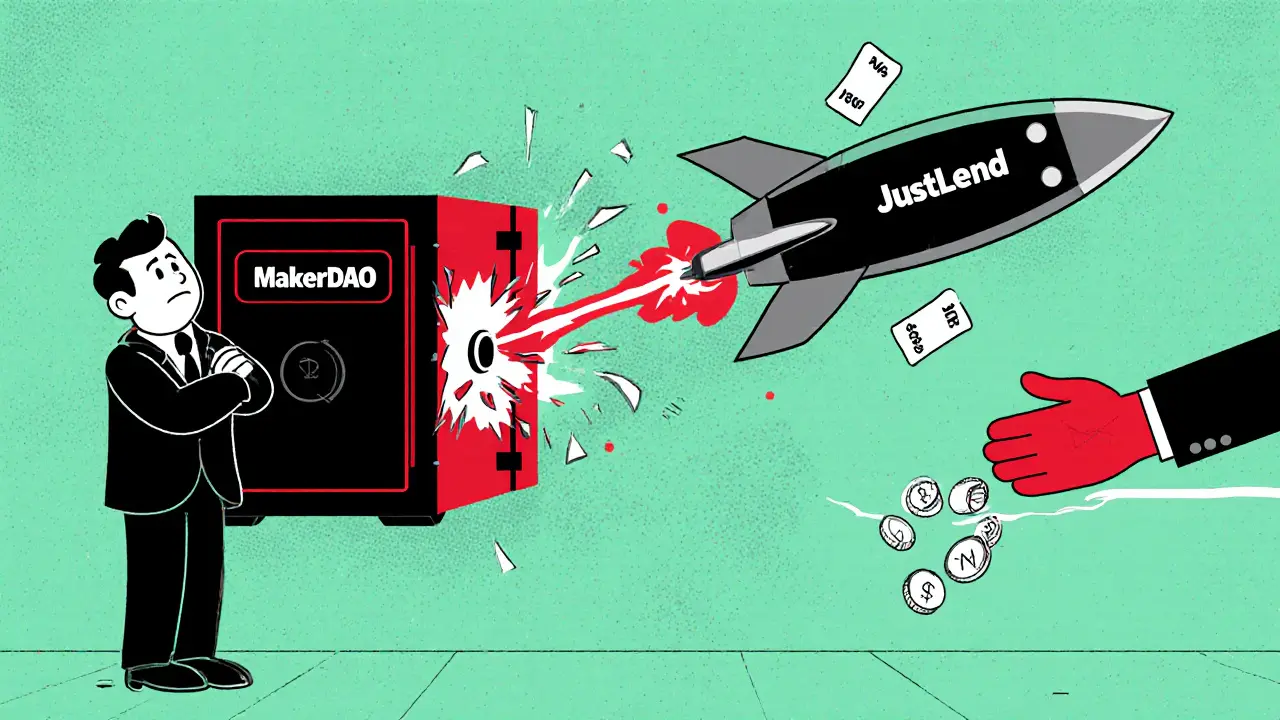DeFi Lending Earnings Calculator
Earnings Calculator
See how much you could earn across leading DeFi platforms in 2025
Estimated Earnings
By 2025, DeFi lending isn’t just a niche experiment anymore-it’s where real money moves. Over $50 billion is locked in decentralized lending protocols, and users aren’t just speculating anymore. They’re using these platforms to earn steady interest, borrow against crypto holdings, and bypass banks entirely. If you’re looking to lend or borrow in 2025, you need to know which platforms actually work, which ones are safe, and which ones will cost you more in gas fees than they pay in interest.
Aave: The Powerhouse with Too Many Features
Aave is still the biggest player in DeFi lending, with $25.3 billion locked in as of March 2025. It runs on 11 blockchains, including Ethereum, Polygon, and Arbitrum, so you can avoid high Ethereum gas fees by switching chains. If you deposit USDC on Polygon, you’ll get around 5.2% APY with near-zero transaction costs. That’s better than most savings accounts.
What makes Aave stand out? Flash loans. These let you borrow money without collateral-for just a few seconds-if you use it to execute an arbitrage or trade. In 2025, over $4.2 billion in flash loans were processed monthly. Aave also has a $100 million Safety Module backed by AAVE tokens, which kicks in if a borrower defaults. It’s one of the most secure DeFi protocols ever built.
But here’s the catch: Aave is complicated. Over 37% of negative Trustpilot reviews mention confusion over multi-chain transfers and rate switching. One user lost $47 in failed transactions because they picked the wrong network. If you’re new to DeFi, Aave’s interface feels like a cockpit with 50 switches. You don’t need all the features. But if you do-like credit delegation or collateral swapping-you won’t find a better tool.
Compound: The Reliable Workhorse
Compound is older, simpler, and quieter. It’s been running since 2018 without a single major exploit. That’s rare in DeFi. Its TVL sits at $8.7 billion, mostly on Ethereum. Interest rates adjust every 12 seconds based on how much of a token is being borrowed. If everyone’s borrowing DAI, the rate goes up. If no one is, it drops. It’s pure supply and demand, no middleman.
Compound pays 3.1% to 6.5% APY on stablecoins like USDC and DAI. Not the highest, but steady. Its biggest weakness? Limited asset support. Only 22 tokens compared to Aave’s 53. And if you’re on Ethereum, gas fees are brutal. During peak usage in March 2025, a single transaction cost $4.27. That eats into small deposits fast.
But if you want something that just works-no flash loans, no complex settings, no chain-hopping-Compound is the most trustworthy option. Institutional investors love it. Hasu from Delphi Digital called it “the safest choice for institutional capital.” If you’re holding $10,000 or more in stablecoins and want to earn yield without stress, Compound is your play.
MakerDAO: The Stablecoin Engine
MakerDAO doesn’t lend you money directly. It lets you mint DAI, a decentralized stablecoin pegged to $1. You lock up ETH or other approved assets as collateral-minimum 150% of the DAI you want. So if you want $10,000 in DAI, you need to deposit at least $15,000 in ETH. Then you pay a small stability fee (1.5-3.2% APY) to keep the loan open.
DAI is the most trusted stablecoin in DeFi. In Q1 2025, it maintained a 99.87% peg. That’s better than most centralized stablecoins. JPMorgan even started using MakerDAO’s system in April 2025 to lend $1.2 billion to institutions. That’s huge.
But managing a MakerDAO vault is hard. You have to watch your collateral ratio. If ETH drops 30% in a day, your vault could get liquidated. In March 2024, 23% of new users got liquidated during a market crash. YouTube tutorials are full of people crying about lost collateral. It’s not beginner-friendly. But if you understand the mechanics, MakerDAO gives you access to a global, censorship-resistant dollar. No bank account needed.

JustLend: Speed and Dirt-Cheap Fees
If you hate waiting and hate paying fees, JustLend is your platform. It runs on TRON, which processes transactions in 3 seconds and charges less than $0.001 per transaction. In 2025, it handled 1.2 million daily transactions. Users report borrowing $5,000 in USDT against their TRX in under 5 seconds for a fee of $0.002.
It offers 6.1% to 8.9% APY on major assets-higher than most Ethereum-based platforms. On CryptoCompare, it has a 4.7/5 rating from over 200 reviews. People love the speed. One user wrote: “Beats any centralized platform.”
But JustLend has trade-offs. It’s mostly isolated to TRON. You can’t easily connect it to Ethereum wallets or use it with other DeFi apps. It doesn’t have flash loans, safety modules, or institutional backing. It’s fast and cheap, but it’s also a closed system. If you’re a TRON user who wants to earn yield without hassle, JustLend is unbeatable. If you want to integrate with the broader DeFi ecosystem, it’s a dead end.
Morpho: The Quiet Yield Optimizer
Morpho doesn’t run its own lending pool. Instead, it connects lenders and borrowers directly across Aave and Compound. Think of it like a broker that finds the best rates for you. In 2025, it boosted lender yields by 1.8-2.3% and cut borrower rates by 1.5-2.1% compared to the underlying protocols.
It’s brilliant for advanced users who want maximum returns with minimal effort. You deposit your USDC into Morpho, and it automatically routes your funds to the pool offering the highest rate-whether that’s Aave on Arbitrum or Compound on Base. No manual switching. No chain-hopping.
But it’s not for beginners. Morpho’s interface hides complexity behind layers. 71% of beginners in Morpho’s own survey said they were confused by the dual-layer structure. And support response times on Discord average 3.2 hours-much slower than Aave or Compound. If you’re tech-savvy and want to squeeze every extra percentage point out of your deposits, Morpho is the hidden gem. If you’re just starting out, you’ll get lost.

What to Choose in 2025?
Here’s the quick guide:
- For beginners: Start with Compound. Simple, safe, reliable. Avoid the noise.
- For maximum yield: Use Morpho to auto-optimize across Aave and Compound. But only if you’ve used DeFi before.
- For low fees and speed: Go with JustLend on TRON. Great if you’re already in the TRON ecosystem.
- For institutional-grade security and features: Aave is still the leader. Just learn the chains first.
- For decentralized stablecoin access: MakerDAO is the only way to mint DAI without a bank. But be ready to monitor your collateral.
One thing all platforms have in common: high yields aren’t sustainable forever. Fidelity Digital Assets found that 78% of institutional investors think current APYs are subsidized. That means rates will likely drop over time. Don’t chase 25% APY on risky tokens. Stick to stablecoins like USDC, DAI, or USDT. They’re the real foundation of DeFi lending.
Common Mistakes to Avoid
- Not checking the chain. Depositing USDC on Ethereum when you meant to use Polygon? You’ll pay $5 in gas for a $20 interest payout. Always confirm the network.
- Ignoring liquidation thresholds. If your collateral ratio drops below 130-150%, your position gets sold automatically. Keep a buffer.
- Using too much leverage. Borrowing 90% of your collateral? That’s asking for trouble during a 10% price drop.
- Not testing small amounts first. Try lending $50 before locking in $5,000. See how the interface works. Watch the rate change.
- Trusting new platforms without audits. TrueFi had a $6 million hack in February 2024. Stick to platforms with 10+ audits from OpenZeppelin or Trail of Bits.
Regulation Is Coming
By June 2025, the EU’s MiCA law will require all DeFi platforms serving European users to implement KYC and AML checks. That means some platforms will start blocking users from certain countries. The SEC’s ‘Project Texas’ is also targeting yield generation. If you’re in the U.S., expect more restrictions. Don’t assume DeFi is fully unregulated anymore. It’s becoming a hybrid system-part crypto, part finance.
The future belongs to platforms that can balance innovation with compliance. Aave and Compound are already adapting. Smaller platforms might not survive. That’s why sticking with the top five is smarter than chasing the next big thing.
What’s the safest DeFi lending platform in 2025?
Compound is the safest. It’s been live since 2018 without a major exploit, has conservative risk settings, and undergoes regular audits. Aave is a close second due to its Safety Module and multi-chain redundancy. Avoid newer platforms without at least 10 security audits.
Which platform offers the highest APY in 2025?
JustLend on TRON offers the highest APY for stablecoins-between 6.1% and 8.9%. Morpho can push yields even higher by optimizing across Aave and Compound, sometimes reaching 9-10% on USDC. But higher yield often means higher risk or complexity.
Can I lose money using DeFi lending platforms?
Yes. You can lose money through liquidation (if your collateral drops too fast), smart contract exploits, or high gas fees eating into small returns. Never lend more than you can afford to lose. Use only stablecoins for safety. Avoid borrowing against volatile assets unless you understand the risks.
Do I need a wallet to use DeFi lending platforms?
Yes. You need a non-custodial wallet like MetaMask, Trust Wallet, or Phantom. These let you connect directly to the protocols. Never deposit crypto into a DeFi platform through an exchange or centralized service-those aren’t true DeFi.
Are DeFi lending yields taxable?
In the U.S., interest earned from DeFi lending is treated as ordinary income by the IRS. You owe taxes on the dollar value of the interest when you receive it. Keep records of every transaction. Use tools like Koinly or TokenTax to track taxable events.
What’s the difference between Aave and Compound?
Aave supports more blockchains, more assets, and has advanced features like flash loans and credit delegation. Compound is simpler, with fewer assets and only Ethereum, Base, and Optimism support. Aave is better for advanced users; Compound is better for those who want reliability without complexity.
Is MakerDAO still worth using in 2025?
Yes-if you need DAI. MakerDAO is the only way to mint a truly decentralized, crypto-backed stablecoin without a bank. It’s used by institutions like JPMorgan. But it’s not for earning high yield. The APY on DAI savings is low (1.5-3.2%). Its value is in stability and decentralization, not returns.
If you’re reading this in late 2025, the DeFi landscape has changed a lot-but the core idea hasn’t: you don’t need a bank to earn interest or borrow money. The best platforms aren’t the flashiest. They’re the ones that keep your money safe, charge low fees, and let you sleep at night.
